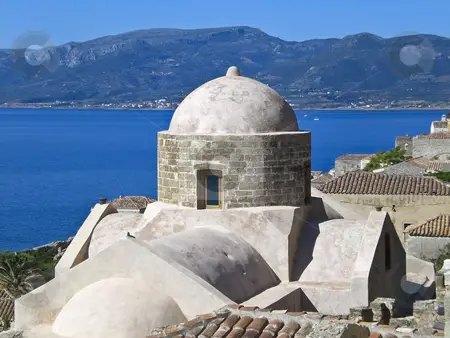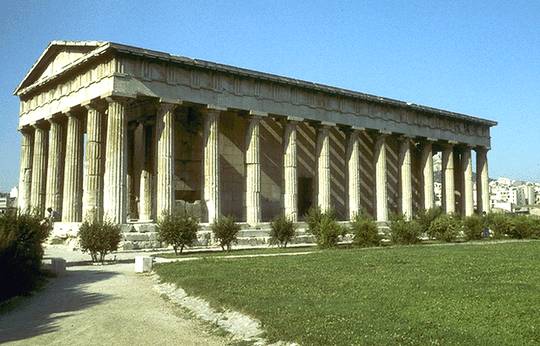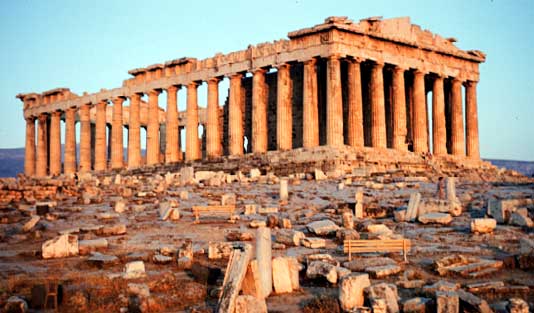The buildings of the Ancient Greek period were brilliantly constructed and followed a definite pattern in their constructions. The masterly architecture of the Ancient Greeks was in full bloom during the Ancient Greek period, especially in the post-Mycenaean period. Ancient Greek buildings reached a point of extinction during the period of time ranging from the close of the Mycenaean period till about the end of the 7th century BCE. The civilization’s economy and the people’s prosperity finally improved after the end of the 7th century BCE and new architecture emerged in the cities. Urban architecture was very different from other contemporary constructions from the Classical Age and has also been rarely found in the later periods of civilization.
Materials used for Construction
Different kinds of materials were used in the construction of different materials from Ancient Greece. The same was the case with the construction of the building as well. The most common material used for the construction of the roof of a building was wood. It was used for supporting the roof beams. Plaster was used for making sinks and for making bathtubs in houses.

The walls of the houses were made of unbaked bricks. The columns, walls, and the upper portion of the houses were made out of limestone and marble. Terracotta was also in use to make roof tiles. These materials were used in constructing five simple types of buildings, which have been mentioned in detail in the later section.
Types of Ancient Greek Buildings
- Religious buildings
- Civic buildings
- Domestic buildings
- Funerary buildings
- Recreational buildings
Among the religious buildings, the temple was amongst the finest constructions of the Ancient Greeks. It served a dual function. Firstly, it served the functions of the modern Church. Secondly, it served as a place where the deity was safely placed and kept, out of public misuse. In this way, the sanctity of the deity was also ensured and maintained. The offerings that were made to the deity were stored in a place which was called the cellar. It was a key part of the religious lives of the Ancient Greeks.

The circular temple or the Tholos was another popular ancient building of the Classical Age of the Ancient Greeks. This was a place of worship for the goddess Athena. There was a porch attached to this structure which served as the path leading to the temple sanctuary. The fountain house was a site from where the women filled their vases. It was a perfectly blended devotional and recreational structure.

The towns often contained gymnasiums that were visited by the men. It was a common feature of the urban way of life. In the towns, a council chamber was built which formed the courthouse, where judicial activities were carried out. The Ancient Greek Theatre was a place of entertainment for the public. They were so well maintained and well preserved that they survive until today. It is one of the rare surviving examples of Ancient Greek architecture and popular culture which show the mastery of the Ancient Greeks in these spheres of culture and creativity.
Types of Ancient Greek Architecture
- the Doric style of architecture, and
- the Iconic style of architecture.
The Doric style of architecture was prominent mostly in the mainland of Ancient Greece while the Iconic style of architecture has been found mostly in the cities of Ionia. Among these two styles of architecture found in the buildings of Ancient Greece, the Doric style was the more austere and formal of the two. The Iconic style of architecture was perceived as the more ornamented and relaxed one.
Examples of Ancient Greek Architecture
Stoa
It is an architectural term in Greece to describe a covered walkway or colonnade, usually designed for public use. The Stoa Poikile of Athens, built in the 5th century BCE, was a prominent example of such architecture.
Bouleuterion
Fortifications
Fortifications of the Ancient Greeks are known from the Mycenean times of the Bronze Age where megalithic architecture was the popular trend. There were also pieces of evidence for stone-built fortifications in Ancient Greece. In Attika, Hellenistic and Classical buildings have been found and at Palairos in Epirus, massive fortifications of the citadel have been found.
Fountain House
Conclusion
The various discussions surrounding the growth and development of architecture and buildings in Ancient Greece have shown the deep interest and expertise of the Ancient Greeks in maintaining their rich legacy of continuing their crafty and creative aspects in these fields. The Ancient Greek buildings are not only examples of good craftsmanship and expert building and designing capabilities, but also conscious efforts of the builders in showcasing the activities of their daily lives and preserving their traditions for the generations to come. The distinct style, nature, and finesse of the Ancient Greek workers have not been found in any other Hellenistic or Classical civilizations of contemporary times. Like every other sphere of the Ancient Greek way of life, their activities in the building and architectural sphere were also one of a kind- unique, effective, and worthwhile.